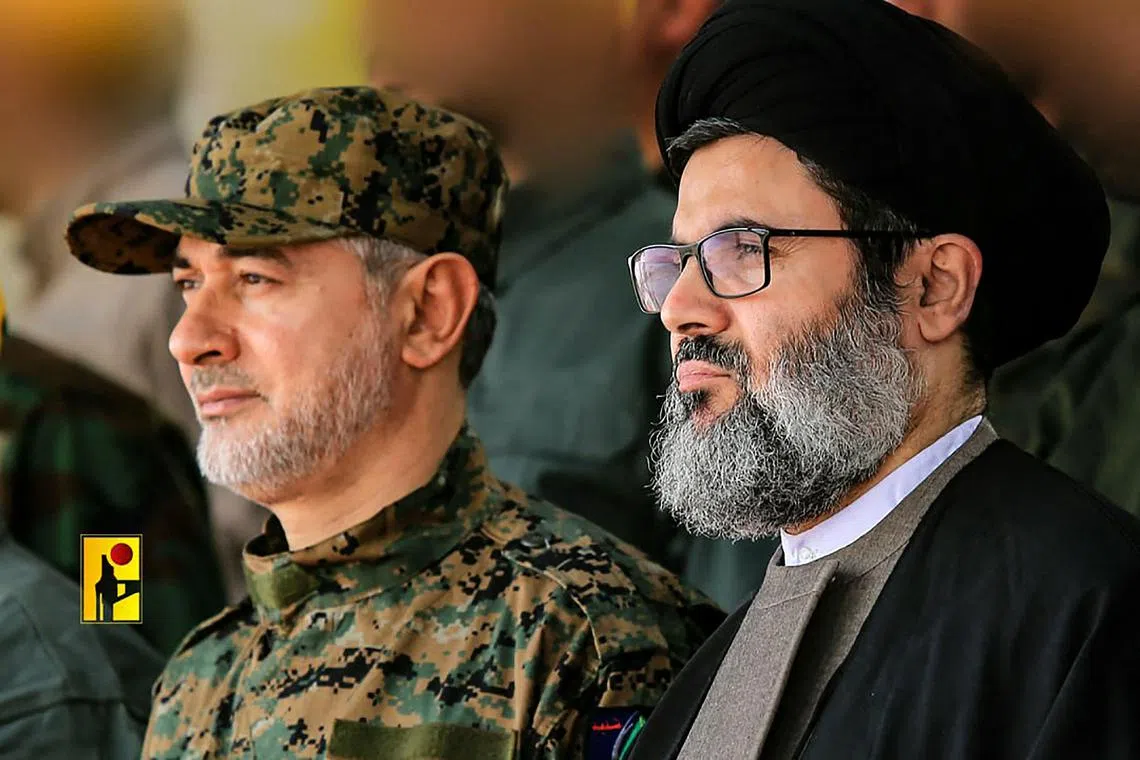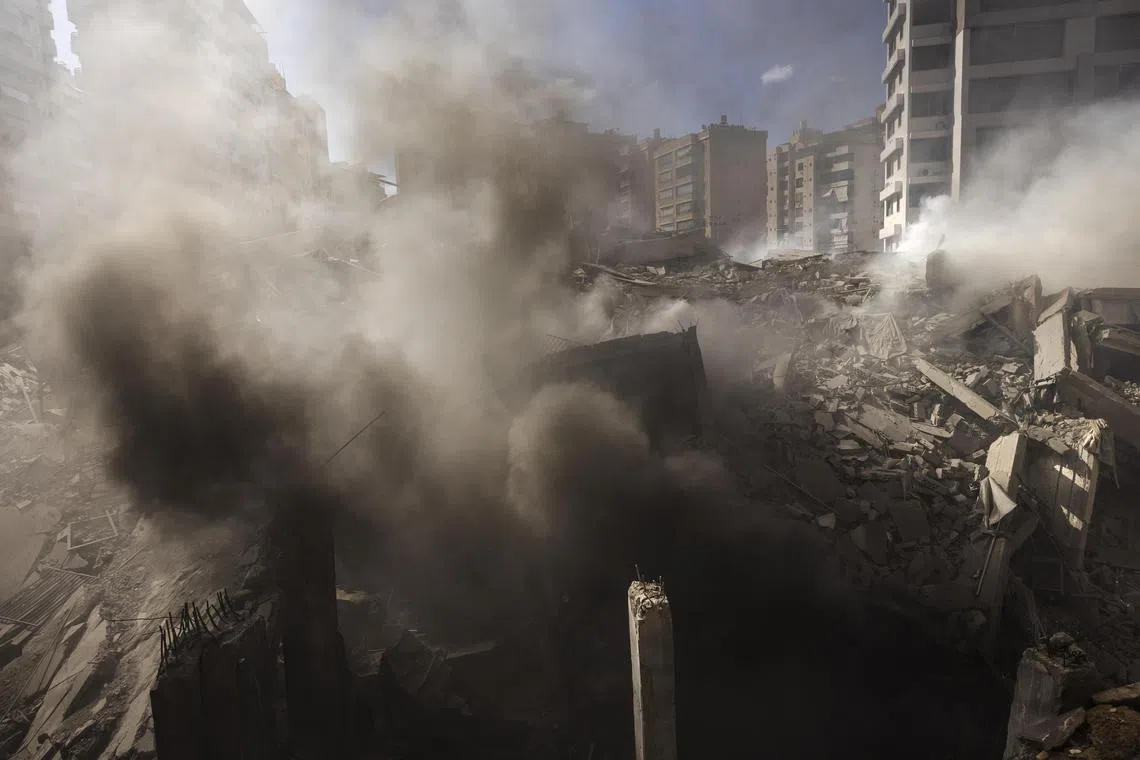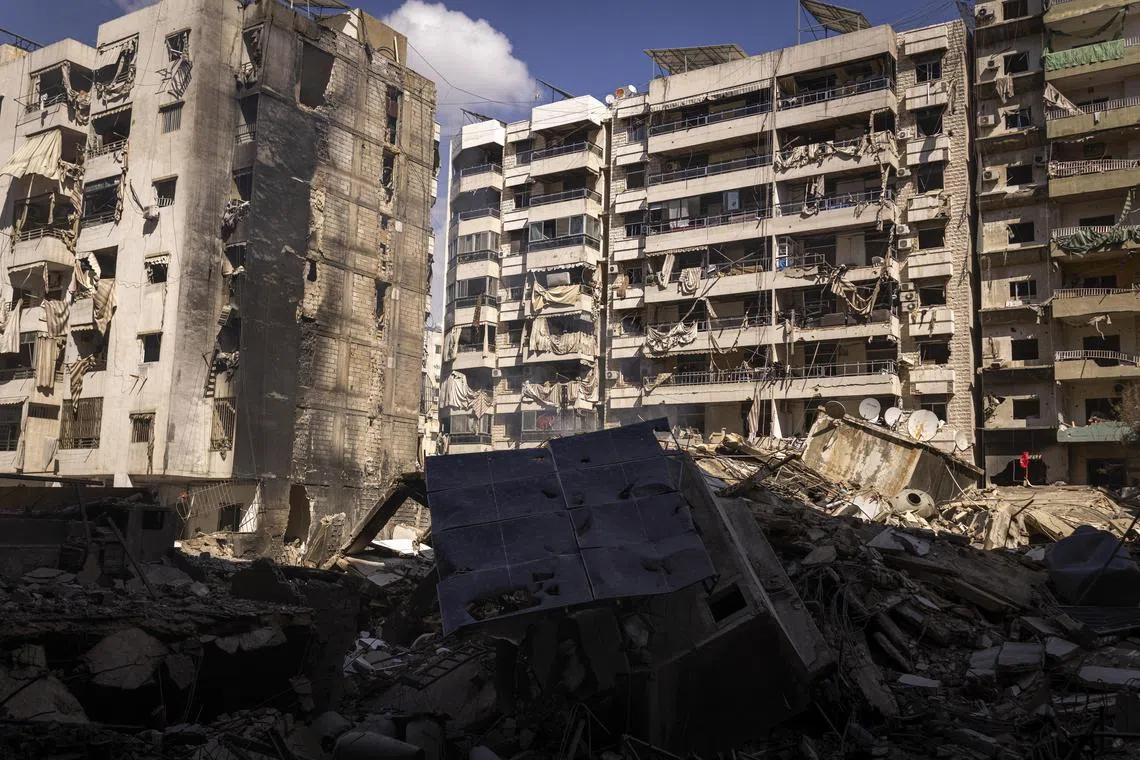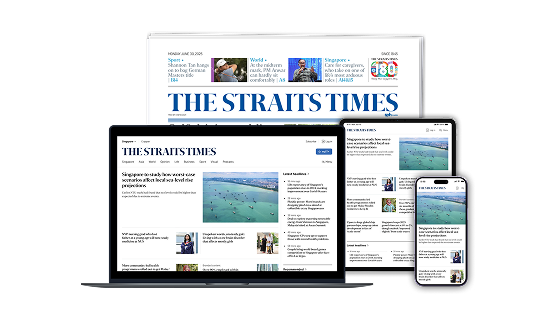Israel bombs Beirut site, targeting presumed successor of slain Hezbollah leader
Sign up now: Get ST's newsletters delivered to your inbox

An undated handout photo released on Sept 21 shows slain Hezbollah top commander Ibrahim Aqil (left) and senior Hezbollah official Hashem Safieddine.
PHOTO: AFP
Follow topic:
TEL AVIV – The Israeli military unleashed an intense bombing campaign against an underground bunker near Beirut early Oct 4 in a bid to target Hashem Safieddine, a cousin and the presumed successor of the assassinated Hezbollah leader, Hassan Nasrallah, according to three Israeli officials.
Israeli planes bombed a meeting of senior Hezbollah leaders outside the Lebanese capital, according to the officials, who spoke on condition of anonymity to discuss intelligence matters. The bombardment was one of the heaviest in the area since the war began in October 2023, according to Lebanon’s state-run news agency.
A series of explosions rocked the area near Dahiya, the densely populated area south of Beirut, the Lebanese capital, where Hezbollah holds sway. The shock waves rippled across the city, shaking buildings, and people at least 24km away could hear them.
The fate of the Hezbollah leaders, including that of Safieddine, was not immediately clear.
The strikes came hours after the Israeli military issued evacuation warnings

Smoke rises from the wreckage after a week of Israeli air strikes in Dahiya, the predominantly Shia southern suburbs of Beirut, on Oct 2.
PHOTO: NYTIMES
Israel’s evacuation orders covered areas farther north than those in previous Israeli warnings and included Nabatieh, one of the largest cities in southern Lebanon. The cities and towns lie above the upper boundary of a buffer zone that the United Nations established after Israel and Hezbollah fought a month-long war in 2006.
The war has been threatening to expand even further as Israel weighs a possible strike on Iran, which supports Hamas and Hezbollah, after Tehran fired 200 missiles at Israel on Oct 1 in retaliation for the assassinations of Nasrallah, Hezbollah’s longtime leader, last week; Hamas’ political leader, Ismail Haniyeh; and an Iranian commander.
Israel, with the help of the United States, Britain and France, shot down most of the missiles, but one man in the Israeli-occupied West Bank was killed.
Israeli officials have threatened a forceful response to Iran’s barrage, putting the Middle East even more on edge. Prime Minister Benjamin Netanyahu of Israel said that Tehran “made a big mistake – and it will pay for it”
Iran’s mission to the United Nations said the Iranian government had warned the United States that it would strike back if Israel retaliated.
“Our response will be solely directed at the aggressor,” the mission said in a statement. “Should any country render assistance to the aggressor, it shall likewise be deemed an accomplice and a legitimate target.”
US President Joe Biden said Oct 2 that he would oppose an Israeli strike on Iran’s nuclear facilities and that Israel should respond “in proportion.” But on Oct 3, Mr Biden, when asked if he would support an Israeli strike on Iran’s oil facilities, said: “We’re discussing that. I think that would be a little... anyway.”
His remarks jolted oil markets, sending the price higher. There was no immediate comment from Israel or Iran.
Earlier on Oct 3, the Lebanese army said for the first time since the war began that it had exchanged fire with the Israeli military after one of its soldiers was killed by Israeli fire. Although the clash appeared to be contained, the exchange was a potentially dangerous development. Lebanon’s armed forces are backed and funded by the United States and are loyal to the state of Lebanon, not the Iranian-supported Hezbollah, and are not actively engaged in combat with the Israeli military.
The Israeli military has said it is attacking Hezbollah to stop it from firing rockets and drones into northern Israel so that the 60,000 Israelis who have evacuated can return. Hezbollah started targeting northern Israel more intensively nearly a year ago, in solidarity with Hamas after it led the Oct 7 attack on southern Israel and prompted the war in the Gaza Strip.
The military said it had struck about 200 targets in Lebanon overnight, including local government offices in a large town, Bint Jbeil, near the border with Israel, where it killed 15 people it described as Hezbollah fighters. About 190 rockets and other projectiles were also fired into Israel from Lebanon on Oct 3; most were shot down or fell in open areas, according to the Israeli military.
In the West Bank, an Israeli fighter jet struck what the military called Palestinian militants in the city of Tulkarem. At least 18 people were killed, the Palestinian Authority’s Health Ministry said. The Israeli military later said it had “eliminated” the head of the Hamas network in the city, along with other militants.
The attack was unusual because Israel typically has used drones, not jets, to strike in the West Bank since Oct 7. And the toll was high for the West Bank, which is home to about 3 million Palestinians and 500,000 Israeli settlers.
Mr Suleiman Zuhairi, a former Palestinian deputy minister who lives on the outskirts of Tulkarem, said Israel had not carried out such a bombardment for years, if not decades. “The blast was terrifying – my house trembled from the shock wave,” said Mr Zuhairi, who added that he lived well away from the reported blast site.
In its latest evacuation order in southern Lebanon, which has been heavily bombed by Israeli warplanes, the Israeli military told residents of 20 additional towns and cities to leave their homes immediately and not to move toward the Israeli border.
“Save your lives,” the Israeli military’s Arabic-language spokesperson, Avichay Adraee, wrote on social media.
“Anyone who is near Hezbollah elements, installations and combat equipment is putting his life at risk. Any house used by Hezbollah for its military needs is expected to be targeted.”

A destroyed street in Dahiya, the predominantly Shia southern suburbs of Beirut, after a barrage of Israeli air strikes on Oct 2.
PHOTO: NYTIMES
At least 1,600 people have been killed by Israeli air strikes in Lebanon, according to Lebanese health officials (the numbers do not distinguish between civilians and combatants), and about one million people have been driven from their homes
The Health Ministry said that 37 people were killed and 151 injured in Israeli attacks across the country on Oct 3 alone.
On Oct 3, an Israeli air strike in the Bachoura neighbourhood of central Beirut, the Lebanese capital, hit a building hundreds of metres from the Lebanese Parliament and Western embassies. Nine rescue workers from a Hezbollah-affiliated civil defence group were killed and 14 others were wounded, according to the Lebanese Health Ministry.
Mr Hassan Ammar, a retired teacher, said he was asleep in his apartment on the 10th floor of the building when the air strike hit about 12.30am.
“We heard multiple explosions hitting our building with a very, very loud sound,” said Mr Ammar, 65. He and his wife ran downstairs to leave, but when they reached the second floor, they found the entire floor had been destroyed.
“I don’t feel safe in Beirut any more,” Mr Ammar said. “This is a destructive war.”

Demolished apartment buildings in Dahiya, the predominantly Shia southern suburbs of Beirut, after a barrage of Israeli air strikes, on Oct 2.
PHOTO: NYTIMES
Two Israeli officials who spoke anonymously to discuss sensitive information said the Israeli military had earlier on Oct 3 targeted Hezbollah commander Rashid Shafti, who was in charge of the group’s telecommunications and computer division in Beirut. His condition was unclear.
On Oct 3, the Israeli military said that another soldier had died in southern Lebanon, the ninth since it announced early Oct 1 that its ground invasion into its northern neighbour had begun.
The Israeli military has said its operation would be “limited, localised and targeted”. But the military recently announced that it was deploying a fifth division of soldiers to the Lebanese-Israeli border – exceeding the three divisions that currently have forces committed to the war in Gaza – suggesting it was preparing for a prolonged fight against Hezbollah, analysts said.
The Israeli military has not stopped its attacks in Gaza as the war there nears the one-year mark. On Oct 3, the military said it had killed three top Hamas officials, including Rawhi Mushtaha, a close confidant of Yahya Sinwar, Hamas’ leader, in an air strike three months ago. Hamas did not immediately comment. NYTIMES

